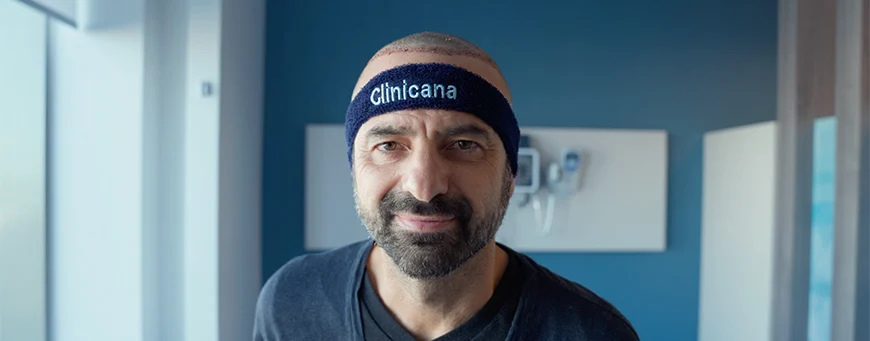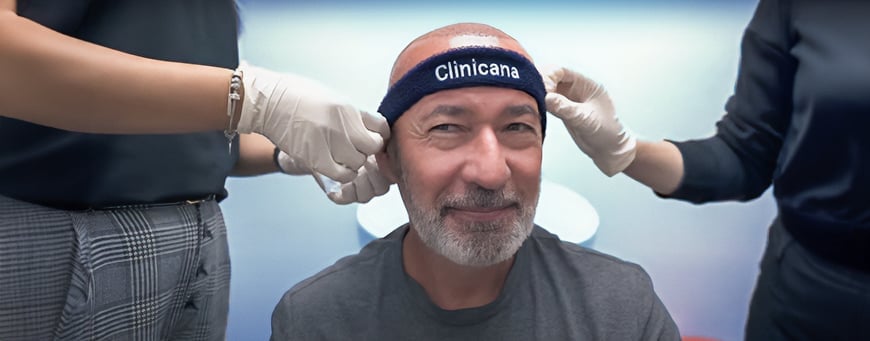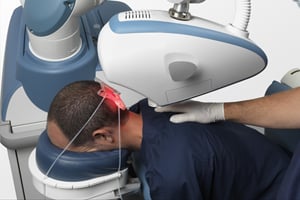Robotic hair transplant: all the truth
Robotic hair transplant is a new term that has become popular recently, and many companies are using it as a commercial tool to attract people who are looking for a solution to baldness. But, when we talk about robotic hair transplant vs FUE method, what is the real difference?
Hair transplants date back to the 1950s; the first hair transplant was performed in 1952 and since then, there have been continuous developments in hair transplant methods and techniques. Because of the affordable hair transplant cost in Turkey, some people is asking if we perform ARTAS robotic FUE hair transplant at our clinic in Istanbul.
However, and first of all, we would like to give you some information about this technology, its possibilities but also its limitations, away from commercial marketing goals.
How is performed a robotic FUE hair transplant?
To start with the procedure, the robotic system applies a small rectangular screen to the back of the scalp after the patient sits down in the robotic chair. Before starting the hair transplant, the donor area -which is automatically detected– will be scanned by the robot and it will take 3D photos of this region to determine which follicles should be picked and extracted. The robot identifies this way follicular units, and begins extraction.
Most of robotic hair transplant systems just extract hair follicles from the donor area, and the medical staff has to complete the rest steps of the hair transplant. The main role of robot is therefore to overcome the lack of experience in the follicles extraction step by the medical team, to keep follicles in the best conditions and to protect the donor area from scars.
However, this doesn´t represent a problem for trained medical staffs and well qualified experts, as we have in our clinic in Turkey. Anyway, let´s see the robotic hair transplant procedure step by step.
Step 1: Determine the frontal hair line
The frontal hair line is determined in a robotic hair transplant system through an interactive program that determines the number of harvested grafts, and the frontal hair line and its shape; so it can be an alternative to the human hand, which is the basis for cosmetic procedures.
As we know, beauty needs a human touch to obtain natural results, while in a robotic hair transplant, this beauty is made by a machine so it will not be as good as the natural one. Besides this, drawing the frontal hair line needs to determine where are the facial muscles, and requires a communication between the doctor and patient, involving touching the frontal area and determining the muscles place to have a natural and more aesthetic result.
Step 2: Follicles extraction
This step is considered as the main phase of a hair transplant because it requires very good experience to determine the angle and depth of picking to extract alive hair follicles and to prevent their degradation, just to ensure that they will produce new hair after transplantation.
However in robotic technique, expert human hand has been replaced with a robotic arm that extracts the hair follicles; and as we mentioned, robot is a dumb machine and can’t perform this operation alone, but under the supervision of an experienced person; there are two main reasons for this:
- Robot can’t know what punches size should be used in each case (something determined according to patient’s follicles) because some follicles are thick and other fine, and each type requires a special punch to extract. So in the end, robotic hair transplant system needs an expert to transmit it the right instructions.
- Robot can’t decide the donor area extent (where the follicles should be taken from) to prevent over-harvesting. In fact, it doesn’t have the skill to go to all parts of the donor area to extract hair follicles, even with latest updates.
Step 3: Opening channels
As we mentioned above, robot’s role ends after extracting the follicles, so the medical staff should complete the other steps of hair transplant. The opening channels stage is very important because the angle and depth of the opened channels plays an essential role in hair transplant success.
Mistakes that are done during channels opening can be very harmful; i.e., unqualified medical staff may cause infections in the scalp, which can develop to a necrosis and ending in follicles death and a real bad appearance… So choosing the right clinic to do your hair transplant operation is very important, and this clinic should have a very qualified staff… not just the latest fashion-forward machine!
As we know, a hair transplant operation is a cosmetic operation like rhinoplasty; so if using robots was the best solution, we would see robots doing rhinoplasty (for example)… but there is nothing like that! So the fact is that human sense is the basis in plastic surgery to give people a natural looking.
Step 4: Follicles implantation
This step is the easiest stage of a hair transplant, and implies implanting the extracted follicles in the opened channels in the recipient area.
After reading all this information, we can say that the robot task is just to extract grafts from the donor area, so it could replace the medical team in this step -if they lack of experience- and shorten the time needed to complete the hair transplant and to keep grafts alive… but the medical team will have to complete the remaining steps.
As we mentioned before, in the case of clinics with highly qualified staff like those we have in Turkey, there is no need for this technique, and human sense will provide the patient with an aesthetic and natural appearance… something that a robot simply can’t do .
Advantages of using the robotic system
We can say anyway that the robotic hair transplant system is a promising new technology and can give some results; however, like many things, it has advantages but also disadvantages. Main advantages are:
- The degree of precision in harvesting and implanting hair is higher
- As with other classic methods, it doesn’t require stitching
- Because of being a procedure that doesn’t leave scars and doesn’t require stitching, recovery time is shorter
What are the disadvantages of using a robot in hair transplants?
In summary, the main disadvantages are the following:
Robot is a dumb machine
The robot can’t work without a highly qualified doctor: it can’t give aesthetic results like the human sense can do, which is the basic in plastic surgery; only if there is no human experience the robot can be good solution. As a simple example, there are many printers that can produce amazing paintings, but manual graphics (i.e. the Mona Lisa) are more beautiful and preferable for all the people.
Robotic hair transplant system is not suitable for all patients
A study in dermatology at Cornell Weill Medical Center, New York, posted on NCBI National Center for Biotechnology Information, concluded that the robotic system is not suitable for the patients who have blond or red or gray hair; this is because the robot finds difficulties in locating the grafts and extracting them.
Although may be dying hair could solve this problem, a robotic hair transplant is more appropriate for patients with dark hair (black and brown). Also, this method is not suitable for patients with curly hair and therefore is a quite limited solution that is not available for all people.
Cannot determine and draw the frontal hair line accurately
There must be an experienced doctor who should examine the muscle layers in the patient, which vary depending on the age. After that, the doctor has to determine the shape and place of this line to keep muscle layers healthy and achieve an aesthetic look according to patient’s desires.
Can’t know the punches sizes that should be used in each case
The size of the punches is determined according to patient’s follicles (because some follicles are thick and other fine and each type requires a special punch). So again, the robotic hair transplant system needs an expert to transmit it the right instructions.
Can’t define the donor area extent
This area is where follicles should be taken off, and not defining it correctly can result in over-harvesting. In fact, even the most modern robots can´t access to all the parts of the donor area to extract the hair follicles.
So, when can a robotic hair transplant be performed?
A robotic hair transplant can be performed only in the following cases and conditions:
- If the robot is assisted by a specialist in hair transplant during the procedure
- If you have 7 –8 hours time to get this procedure
- You cannot benefit of this method if you have blonde, grey or ginger hair, and also if your hair is curly or Afro-textured.
- If you have enough money, because the cost of a hair implant through this procedure starts somewhere from £ 5,000 (about 6,000 €) in UK.
Conclusion: should I seek a robotic hair transplant?
Our doctors at Clinicana declare that the important thing in any surgery are the doctor´s knowledge and skills, not the tools he/she will use in the operation. Actually, and as we have said, the results of an ARTAS robotic hair transplant will ultimately depend on the medical staff, not the machine.
Even the most sophisticated tools can lead to bad results with unqualified physicians. Robotic hair transplant system is a promising new technique, but it can´t replace a good doctor. Our best advice is that you´d better don´t choose a doctor depending on the tools he/she uses, but on his/her patient´s results. Take a look to our Hair Transplant in Turkey: Reviews sections, and check out by yourself why Clinicana is your best choice for a hair implant in Turkey.

A hair transplant procedure can be a transformative experience. But to ensure your newly implanted follicles thrive, proper aftercare is very essential. This article equips you with key hair transplant recovery tips or post-operative instructions to minimize discomfort, optimize healing, and pave the way for a successful hair transplant journey for you. Hair transplant recovery […]

Dreaming of a full head of hair? Hair transplants are gaining traction, particularly in Turkey as clinics there are characterized by budget-friendly options and skilled surgeons. But, with so many clinics, the way of choosing the right one can be overwhelming. This article will help you find one of those top 10 hair transplant clinics […]

Finding the best hair transplant clinic in Istanbul is a crucial decision. In this article, we will look at some important factors to help you make an informed decision to ensure a successful surgery. How to choose the best hair transplant clinic in Istanbul? Istanbul has emerged as a sought – after destination for hair […]














